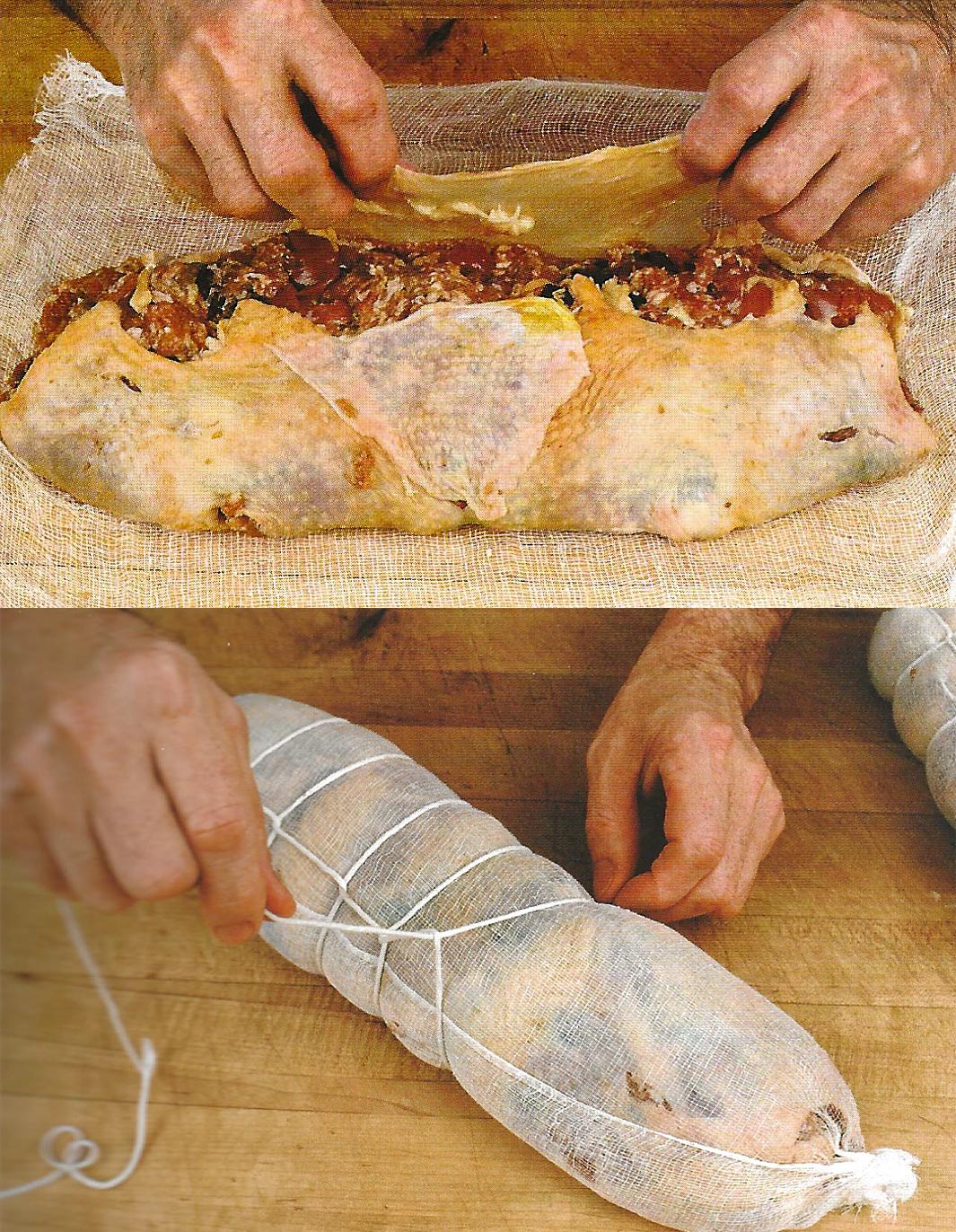
Christopher Hirsheimer
Chicken Galantine
“Galantine” is the name usually given to boned poultry that is stuffed with a forcemeat, poached in a strong stock, and served cold with its natural jelly.
The chicken is skinned, and the skin is used as a wrapper for the forcemeat, seasonings, and other ingredients. For this recipe, the galantine is studded with pistachios and flavored with Armagnac. Black mushrooms not only give taste but lend beautiful color to the dish. Most of the chicken and pork meat is kept in large pieces, with only enough of it ground to bind all the ingredients together. If possible, keep the wrapped galantine refrigerated for at least one day before cooking, to develop flavor.
The galantine can be baked in a pâté mold lined with caul fat, the fatty membrane that encases a pig’s stomach. Leaf lard, as well as the skin of the chicken, can also be used as a wrapper. In our recipe, the skin is spread on a piece of cheesecloth, filled, wrapped, tied with string, and poached in a stock made from the bones of the chicken. The galantine is then cooled in the stock, which is reduced further and served with the galantine as a natural aspic. Properly wrapped, a galantine will keep for a week in the refrigerator after cooking. Cherry-Ginger Chutney (page 274) is a great accompaniment for the galantine.
Serves 12 to 14
Ingredients
- 1 chicken (3½ to 4 pounds)
Forcemeat
- About 1¼ pounds white chicken meat (from chicken above)
- About 1¼ pounds dark chicken meat and trimmings (from chicken above)
- 1¼ pounds pork shoulder meat (about one-third fat)
- 3 large chicken livers (about 4 ounces), cleaned of sinews
Spice Mixture
In an electric spice-grinder or coffee-grinder, grind together until powdered:
- 1 teaspoon whole black peppercorns
- 6 juniper berries
- 6 whole cloves
- ½ teaspoon dried thyme leaves
- ⅛ teaspoon grated nutmeg
- ⅛ teaspoon ground cinnamon
- ⅛ teaspoon cayenne pepper
- 1 tablespoon Armagnac
- ⅓ cup dry white wine
- 2 tablespoons regular salt mixed with ½ teaspoon sodium nitrite (also called pink salt), or replace this mixture with 2 tablespoons curing salt (see box, page 145)
- 2 teaspoons cornstarch
- ⅓ cup shelled pistachios
- ⅓ cup shelled pistachios
- ⅓ cup finely chopped shallots
- 1 cup black mushrooms (my favorite is the black Orpheus, also called black chanterelle) or cèpes (porcini), washed 1 clove garlic, peeled, crushed, and chopped (½ teaspoon)
- (see illustrated garlic preparation, page 170)
Cooking Stock
- About 1 ¼ pounds chicken carcass, neck, and gizzard (from chicken above)
- 1 cup diced onion (see illustrated onion preparation, page 21)
- ½ cup diced carrot
- 4 quarts water
- 2 bay leaves
- ½ rib celery
- ½ cup dry white wine
- ½ teaspoon dried thyme leaves
- ½ teaspoon salt
Method
- Skinning and boning the chicken: Lift the skin at the neck of the chicken, and run a knife along each side of the triangular bone wishbone). Pry out the wishbone with your finger. (Running your thumb behind it will help release it.) To skin the chicken, cut through the skin all the way down the back-bone, and start lifting and pulling the skin, cutting underneath it as necessary to make it come off in one piece, as it will be used as a wrapper for the galantine. Do not worry if there is a hole here and there.
- Keep pulling on the skin and cutting underneath to release it; you will notice that most of the skin, except for that on the thigh bones, will come off without cutting. Pull the skin down the length of the drumstick and off the bone.
- Remove the wings, cutting them off at the joint of the shoulder. The meat from the wings will be ground. To separate the legs from the carcass, cut the little “oyster” off the backbone on one side, so it stays attached to the leg on that side, and break the leg open at the pelvic bone (the joint of the hip). Cut through the joint and pull the leg off. Repeat, releasing the “oyster” on the other side and removing the other leg.
- Cut the breast on either side of the breast-bone, then grab the breast meat from one side, including the fillet, and pull it off; it should come off the carcass in one piece.
- Repeat with the other half-breast. Continue boning and scraping the remaining meat from the carcass.
- Cut the white meat of the breast and the dark thigh meat into 1½-inch pieces. Remove the sinews from the breast fillets, and remove most of the sinews from the drumstick by holding one end of each sinew with a towel and scraping the meat off it with a sharp knife.
- The chicken should yield about 1½ pounds of large cubed pieces (about 1¼ pounds of breast meat and ¼ pound of thigh meat), ¾ pound of other dark meat and little pieces of meat from around the wings (to be ground), and about 1¼ pounds of bones. The rest of the Weight is in the skin. Remove the leanest part of the pork shoulder, and cut it into 1-inch pieces (weighing about 8 ounces). Set the cubed chicken and pork aside. Cut each of the chicken livers into 4 pieces.
- Grind the fattier pork and dark pieces of chicken meat in a meat grinder or food processor (taking care not to overprocess it), to yield a mixture with the texture of hamburger meat. Combine this ground meat in a bowl with the ground spice mixture, Armagnac, white wine, salt, pink salt, cornstarch, pistachios, shallots, mushrooms, and garlic.
- Add the cubed pieces of white chicken meat and pork shoulder, and the chicken liver pieces, and mix well.
- Spread the skin of the chicken, preferably in one piece, on a piece of cheesecloth about 18 inches square. Pile the forcemeat mixture in the center, and bring the skin of the chicken back up over the forcemeat carefully, to enclose it as much as possible. Do not worry if some of the forcemeat is not entirely covered with the skin. Bring the cheesecloth back over the skin, and roll it tightly around the galantine, then twist each end of the cheesecloth to create a tubelike package. Tie at both ends. The galantine will be approximately 12 inches long by 2½ to 3 inches in diameter.
- Attach a piece of string with a double knot to the package end closest to you. Make a loop with the loose end of the string, slide it underneath the galantine, and position it about 1½ inches away from the tied end, then pull gently to create one loop. This is called a half-hitch. Make additional loops every 1½ to 2 inches, repeating until the galantine is completely tied on one side.
- When the galantine is tied on one side, secure the string at the other end, and turn the galantine over. Slide the rest of the string around each of the loops, bringing it under and over each cross-string, so the galantine looks the same on the top and bottom.
- Secure it again at the end where you started. If this is too difficult for you to do, make single ties at 1 ½-inch intervals the length of the galantine to achieve the same effect. Refrigerate the galantine overnight to develop flavor before it is cooked. Meanwhile, make the stock.
- To make the stock: Place the chicken bones in a large pot, and brown them over medium to high heat for at least 15 minutes. (You may need a little dash of oil, because there is practically no fat left on the bones, and the skin has been used for the galantine.) When the bones are browned, add the onion and carrot, and continue browning for 10 minutes. Add the water, bay leaves, celery, white wine, thyme, and salt, bring to a boil, and skim off any foam that forms on the surface. Boil gently for 2½ hours. You should have 6 to 8 cups of stock. (Adjust with water as needed.)
- To cook, arrange the galantine in a narrow pot, so that it fits snugly. Remove most of the fat that has risen to the top of the stock, and pour the stock over the galantine. Add more stock, if needed, so the galantine is covered.
- Heat to a temperature of 180 to 190 degrees (the stock should not boil), and cook 1½ hours, partially covered, or until the galantine reaches an internal temperature of about 150 degrees. Let cool overnight, refrigerated, in the stock.
- Remove the galantine from the cooking liquid, which should be jellied, unwrap the cheesecloth from around the galantine, and dry it with paper towels. At this point, the galantine can be wrapped in plastic wrap and stored in the refrigerator, to slice and serve as desired. It will keep for at least a week.
About Curing Agents
Curing agents are not essential in the making of pâtés or sausages, but the meat is a more attractive pink color when cured, and this is achieved with the addition of salt and curing agents, like sodium nitrate and sodium nitrite. Meat curing is a practice that goes back 3,500 years, and ham, frankfurters, corned beef, and sandwich meat are but a few of the meats cured commercially today. Potassium nitrate (saltpeter) used to be the choice curing agent, but it is not used much anymore. Other curing agents, such as “pink salt” or “Prague powder,” are also used in professional kitchens. In our recipes, we use regular salt with the addition of sodium nitrite in a very small amount. Alternatively, although curing or pickling salt (a mixture of regular salt, sugar, sodium nitrate, and sodium nitrite) is sometimes difficult to obtain, it is available upon request in most supermarkets. Morton Tender Quick Meat Cure is a good one; it should be used in the same quantities as the salt it replaces in your recipes.
Recipe Source

Jacques Pépin Celebrates
A fabulous book for people who love to cook. Or for those who want to cook well and are afraid to try. To Jacques Pépin, every meal is a celebration.
Buy now